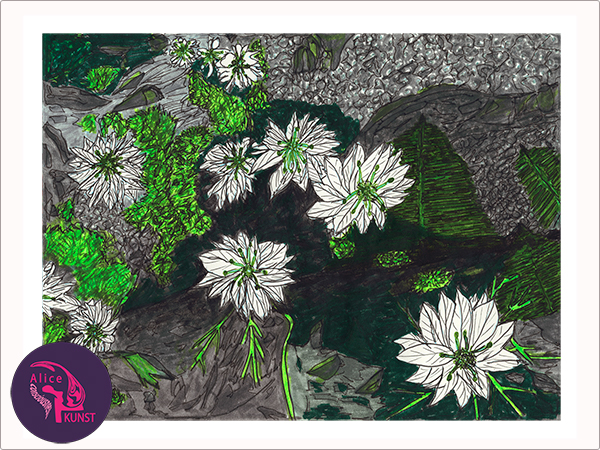The reference to "Death" and "Reconcilation" are rooted in a two-fold experience I had as a child when year after year as part of our November tradition of honoring the dead, my parents would drive up to the Wicklow mountains and have us participate in a ceremony attended by representatives of the German community, governnment leaders, Irish army chiefs, and diplomats from the German Embassy, the American Embassy, and on occasion the British Embassy too would attend. The war cementary was filled with unknown soliders who had accidently crashed and died on Irish soil during World War I and II. As cementaries go it could not have been a more picturesque setting, a point my mother made every year along with an expressed desire to be buried in such a place. Each year as a child I would reverently walk along the stone paths and look at the small stone grave markers in German and wonder who they were, what they looked like, and if their loved ones even knew where they might have ended up.
The November air was bitterly cold and it often rained in a way that would freeze you into a feeling of death. The crowd of fifty of so of us would huddle as close together as possible while the wreaths and the trumpet played national anthems, German hymns were sung, and speeches were made. The experience was solemn and healing at the same time because it provided a moment for a handful of Germans to grieve together and mourn those lost to war in a place that was surrounded by the British narrative of the wars which deemed people like my mother and her kind - my kind: the enemy.
The event which began solemn in the graveyard was transformed from the coldness of death to the warm fires lit across the road at the Centre for Peace & Reconciliation. Frozen feet and hands were warmed quickly inside with volunteers running around with boiled kettles for hot tea and coffee and offering hot scones and "buns" filled with jam and butter across the street and some years when the Ambassador's budget would allow for it, there was a smattering of German cake too. Another speech was given about peace and reconciliation and the hopes for an end to the "Troubles" in northern Ireland which typically started a big debate among the crowd that were Irish while the German contingent seemed more occupied with hugging and catching up with each other.
In a place where peace was deeply set in the earth as much as it was graced by the fast moving river along the side of the cemetary, you could immediately feel a healing presence that seem to flow out of the soil beneath our feet and it's transition in nature to something life giving. There was on top of the ridge a celtic cross standing errect into the sky above as if presiding on behalf of some divine representative much older in wisdom and a consciousness than the huddled human contingent below. We were there only for an hour each year yet the sense of santuary in the wilds of Nature never faltered. In the curve of the ridge it was comforting, ancient and steadfast in its purpose and as I walked the gardens in Seattle in the cold rain and caught a glimpse of Glencree in a corner of wet stones, mosses and delicate flowers, I realized I could chose to find myself in its santuary anywhere.
This was the art of bi-location living that I wanted to capture in this piece.
Join in...
I invite you to become part of the unfolding consciousness experience and email Alice about your insights/thoughts/ideas about what this artwork invokes for you.
